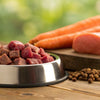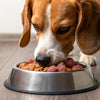Can You Defrost Raw Dog Food? The Best Methods for Safe Thawing
- Houndsy
Table of Contents
- Introduction
- Understanding Raw Dog Food
- How to Safely Defrost Raw Dog Food
- Storage After Thawing
- Ensuring Safe Handling
- Conclusion
- FAQs
Introduction
Did you know that nearly 80% of dog owners believe that their pets deserve a diet that closely mirrors their natural eating habits? For many pet parents, this means considering a raw food diet, which often includes frozen raw dog food. However, one crucial question arises: can you defrost raw dog food safely?
Understanding how to effectively defrost raw dog food is essential for your pet's health and safety. Improper thawing can lead to bacterial growth, spoilage, and even illness. As devoted pet owners, we want to ensure that every meal we serve is safe, nutritious, and delicious for our furry companions.
In this blog post, we will explore everything you need to know about defrosting raw dog food, from the safest thawing techniques to how long you can store it after defrosting. We want you to feel empowered to confidently handle your pup's meals, contributing to an overall healthy diet that enhances their well-being.
What You Will Learn
By the end of this post, you'll have a comprehensive understanding of the best methods to defrost raw dog food and the reasons behind them. We'll delve into the pros and cons of different thawing techniques and answer common questions related to raw food storage, safety, and tips for ensuring your dog’s meals are always top-notch. Ready to join us on this educational journey for the benefit of your furry friend? Let’s dive in!
Understanding Raw Dog Food
Before we discuss thawing methods, let's take a moment to understand what raw dog food is and why it appeals to many pet parents. Raw dog food typically consists of uncooked, minimally processed ingredients like raw meat, bones, fruits, and vegetables. It mimics a natural diet that many believe is healthiest for dogs.
Benefits of Feeding Raw Dog Food
- Nutrient-Rich: Raw dog food is considered nutrient-dense, packed with essential vitamins and minerals that can benefit digestion, skin, and overall health.
- Natural Diet: Many proponents argue that a raw diet aligns with a dog’s ancestral eating habits, providing a diet that is instinctively appealing to their nature.
- Improved Coat and Skin: Dogs often show improved vitality, coat condition, and skin health when on a well-formulated raw diet.
However, while the benefits are compelling, ensuring safe preparation and feeding practices is crucial.
How to Safely Defrost Raw Dog Food
1. Refrigerator Thawing: The Gold Standard
The safest and most recommended method for thawing raw dog food is to use the refrigerator. Here’s how you can do it effectively:
Step-by-Step Process
- Plan Ahead: Remove the raw food from the freezer a day before you intend to serve it. Place it on a plate or in a bowl in the fridge to catch any drips.
- Storage: Ensure the food is packaged in a sealed container to prevent any cross-contamination with other foods.
- Thawing Time: Allow approximately 12 to 24 hours for smaller portions, while larger packages may take longer to thaw completely.
Why This Method Works
- Temperature Control: Keeping the food at a consistent and safe refrigerator temperature (below 40ºF) inhibits bacterial growth.
- Nutrient Preservation: Thawing in the fridge helps maintain the enzymes present in the raw foods, ensuring your pet receives all the intended nutritional benefits.
2. Cold Water Bath: The Quick Fix
If you find yourself in a pinch and need to thaw raw dog food faster, a cold water bath can be an effective method.
Step-by-Step Process
- Preparation: Place the raw dog food in a leak-proof plastic bag, ensuring it is sealed to prevent water from entering.
- Water Bath: Submerge the bag in a large bowl filled with cold water. Change the water every 30 minutes to keep it cold.
- Thawing Time: A smaller portion can take about 30 minutes to an hour to thaw, while larger portions might require additional time.
Why This Method Works
- Rapid Thawing: The cold water bath speeds up the thawing process without exposing the food to temperatures that could facilitate bacterial growth.
3. Counter Thawing: Proceed with Caution
While some pet parents may consider leaving raw dog food on the counter to thaw, we advise caution with this method due to safety concerns.
Why You Should Avoid It
- Bacterial Growth: Leaving raw food out can push it into the "danger zone" (40°F to 140°F) for bacterial proliferation, which can cause foodborne illnesses in pets and humans alike.
- Unpredictable Thawing Time: Depending on the thickness of the food, unfrozen interior portions could remain at unsafe temperatures while the outer layer thaws.
If you must use this method, minimize the time the food is left out and transfer it to the refrigerator as soon as possible.
4. Methods to Avoid
Certain thawing methods are widely discouraged due to the risks they pose for your pet’s health and safety.
Microwave Thawing
Using a microwave to thaw raw dog food is not recommended because:
- Uneven Heating: Some parts of the food may cook while others remain frozen, which can destroy the nutritional value and create hazardous cooked bone fragments.
- Bacterial Growth Risks: Microwaving often results in varying temperatures, risking the introduction of harmful bacteria.
Boiling Water
Similarly, thawing raw dog food in boiling water is not advisable for these reasons:
- Nutrient Degradation: The heat can destroy the nutritional benefits of the raw food.
- Bone Integrity: Cooking bones can make them splinter, leading to choking hazards or potential intestinal harm for your pet.
Storage After Thawing
Once you've successfully thawed your pet’s food, proper storage becomes essential.
How Long Can You Keep Defrosted Raw Dog Food?
- Refrigerator Storage Time: Thawed raw dog food can typically remain safe for consumption in the refrigerator for two to three days.
- Sealed Containers: Store the food in airtight containers to prevent contamination and preserve freshness.
Refreezing Raw Dog Food
If you've thawed raw food but not used it all, you can refreeze it as long as it was:
- Thawed in the refrigerator.
- Refrozen within 3 to 4 days.
- Never left out of refrigeration for more than 2 hours.
While these guidelines allow for some flexibility, frequent refreezing can affect the texture and quality of the meat.
Ensuring Safe Handling
When using any raw dog food, hygiene practices are crucial to safeguard both you and your pet's health.
- Wash Hands: Always wash your hands after handling raw food to avoid cross-contamination with human food.
- Clean Surfaces: Use disinfectants on any surfaces where raw food was prepared.
- Dedicated Containers: Use separate containers exclusively for your pet's raw meals to minimize the risk of foodborne bacteria spreading to your family’s food.
Conclusion
In conclusion, understanding how to safely defrost raw dog food is vital for any pet owner interested in providing their furry friends with a healthy diet. By using proper thawing methods—primarily refrigerator thawing or a cold water bath—you can ensure that your dog’s meals are both nutritious and safe to eat.
As we constantly strive to enhance the lives of our pets, we at Houndsy aim to make feeding a joyful and convenient experience. Our flagship Houndsy Kibble Dispenser is designed to simplify your everyday pet care, allowing you to focus on spending quality time with your canine companion. For the best feeding solution that combines innovative design and functionality, check out the Houndsy Kibble Dispenser here.
FAQs
Q: Can I defrost raw dog food on the counter? A: It's not advisable. While you may be tempted to thaw raw food on the counter, this can lead to unsafe temperatures and increased bacteria growth.
Q: Can I defrost raw dog food in the microwave? A: No, defrosting in the microwave is discouraged as it can lead to uneven thawing and potential cooking of the food, affecting its nutritional value.
Q: How long can I store defrosted raw dog food in the fridge? A: Thawed raw dog food should ideally be used within 2-3 days when stored in the refrigerator.
Q: Is it safe to refreeze raw dog food? A: Yes, if the food was thawed in the fridge, you can safely refreeze it within 3 to 4 days as long as it hasn’t been left out for more than 2 hours.
Q: What is the best method to thaw raw dog food quickly? A: The cold water bath method is the quickest way to thaw raw dog food safely, allowing you to prepare a meal for your pet without compromising safety.













